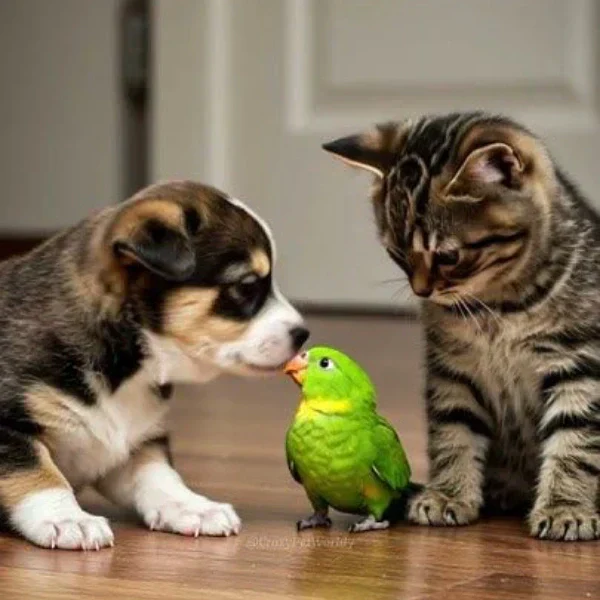Bird flu, or avian influenza, is a viral disease that primarily affects birds but has raised concerns over its potential transmission to other animals, including pets. As a pet owner, you might wonder whether your feathered or furry friends are vulnerable to this disease. In this article, we explore whether pets can catch bird flu, the associated risks, and the precautions you should take to keep your pets and family safe.

Understanding Bird Flu
Bird flu is caused by influenza A viruses, which naturally occur in wild water birds such as ducks and geese. These viruses can transmit to domesticated birds and, occasionally, to mammals such as humans and animals. The highly prevalent strains of concern are H5N1 and H7N9 due to their high pathogenicity in birds and infectivity in other animals. A recent outbreak of H5N1 at Hickman’s Family Farms in Arizona highlights how quickly the virus can spread and devastate large poultry operations in the U.S.
Although avian influenza primarily affects birds, certain mammals, including cats, dogs, and even ferrets, have been found to be susceptible to the virus. This poses a significant concern for pet safety, particularly for those with outdoor access or exposure to wild birds.

Can Pets Get Bird Flu?
Yes, pets can contract bird flu, but the risk depends on the species and level of exposure. Here’s an analysis of how different pets may be affected by bird flu:
1. Dogs:
Dogs are less likely to catch bird flu than cats, but it is still possible. The risk increases if they eat raw birds or have frequent contact with infected birds. However, dog cases of catching bird flu have not been much documented.

Photo by Tima Miroshnichenko on Pexels
2. Cats:
Cats are one of the most vulnerable pets to avian flu. They can become infected with the virus by ingesting infected birds or by contact with dirty surfaces. Instances of cats becoming infected with H5N1 have been noted in some nations, tending to lead to extreme respiratory distress or death.
3. Birds (Pet Parrots, Canaries, etc.):
Pet birds are most likely to get bird flu, particularly when they come in contact with wild birds or where there is an outbreak. Symptoms in infected pet birds include weakness, loss of appetite, and breathing difficulties.
4. Other Pets (Rabbits, Ferrets, etc.):
Ferrets are highly vulnerable to influenza viruses, including bird flu. Other small mammals and rabbits have less risk but must be examined if they live in areas with identified outbreaks.

Cases of Bird Flu in Pets
Bird flu, or avian influenza, is a bird disease, but there have been rare instances in pets. Although the virus does not infect cats and dogs regularly, some strains, like H5N1, have infected and killed them. Some of the most reported cases of bird flu in pets are listed below.
Bird Flu in Cats
Cats have also been the most common pets infected with avian influenza. The virus typically spreads to them by eating contaminated raw food or infected birds.
1. 2004 Thailand:
The first instance of H5N1 in domestic cats was reported in Thailand. Some cats became infected after consuming infected poultry, and a few died. This finding raised alarms regarding the virus's capability to cross species boundaries.
2. 2006 Germany:
In one of the more publicized incidents, a cat on the Rügen island of Germany died of H5N1 after contracting the virus from infected birds. This led to health officials suggesting that cat owners in the infested areas confine their cats indoors.
3. 2023-2024 Poland:
A strange H5N1 outbreak was reported in Poland in 2023 when more than 30 cats tested positive for the virus. The infected cats presented with neurological symptoms and respiratory complications before they died. The origin of the infection was not specific, but it was suspected that it was contaminated food or coming into contact with infected wild birds.
The latest cases in the U.S. have been domestic cats that have contracted H5N1 after eating contaminated raw pet food. Early in 2024, an outbreak was traced to a recalled batch of Wild Coast Raw pet food. Multiple cats became seriously ill, and at least one death was confirmed. Health authorities called on pet owners to avoid feeding raw diets and practice rigorous hygiene when handling pet food.
Bird Flu in Canines
Dogs are less frequently infected with bird flu, but sporadic cases have been reported.
1. 2006 Azerbaijan:
One of the earliest reported cases of H5N1 infection in a dog was in Azerbaijan. A stray dog died after eating infected carcasses of birds. This incident showed that dogs, similar to cats, were susceptible to the virus under specific circumstances.
2. 2015 China:
A survey identified H5N1 antibodies in a few dogs in China. It indicates that they had been infected with the virus. These, however, did not lead to large-scale disease or deaths.
Though bird flu in domestic pets is uncommon, such cases indicate a possible danger posed by the virus. Pet owners can take precautions, such as preventing pets from coming into contact with wild birds and avoiding raw pet foods that may be contaminated.
Symptoms of Bird Flu in Pets
If your pet has been suffering from bird flu, then you must examine the following signs:
- Swelling or discharge from the eyes
- Fever
- Respiratory disturbances (coughing, sneezing, shortness of breath)
- Lethargy or weakness
- Loss of appetite
- Sudden death (in critical cases)
If you observe any of these signs, call your veterinarian right away. Early identification and treatment can enhance the chances of recovery.
How to Protect Your Pets from Bird Flu?
Preventing bird flu in pets involves reducing their exposure to the virus. You can find some helpful measures outlined below:
1. Vaccinate Poultry:
If you have backyard chickens or other birds, make sure to vaccinate them against bird flu. This reduces the likelihood of them passing it to your pets and family.
2. Reduce Exposure to Wild Birds:
Keep your animals indoors or under supervision when outside to avoid coming into contact with wild birds. Stay away from areas where wild birds typically gather, like ponds or parks with high bird concentrations.

3. Practice Good Hygiene:
Wash hands extensively after handling birds or cleaning cages. Clean and fumigate equipment and surfaces coming into contact with birds or their stools.
4. Don't Feed Raw Poultry:
Raw chicken can harbor the bird flu virus. Use commercially available pet food, and do not feed your pets undercooked or raw meat.
5. Track Local Outbreaks:
Keep yourself up-to-date regarding bird flu incidents in your location. The United States Department of Agriculture (USDA) and the Centres for Disease Control and Prevention (CDC) give periodic reports on the avian influenza outbreak.
Can Humans Get Bird Flu from Pets?
Yes, humans can catch bird flu from infected pets, although it is uncommon. Transmission typically occurs through close contact with respiratory secretions, feces, or contaminated surfaces. Pets such as cats and birds, which are more prone to bird flu, can transmit the virus to humans if precautions are not observed. Do not touch sick pets unless you wear gloves or masks to avoid the risk. Also, wash your hands immediately after handling pets or cleaning the areas where pets live. Isolate your pet and call a veterinarian if you suspect your pet has bird flu. Keeping current with local outbreaks and following good hygiene are important to safeguard your pets and family.

Conclusion
Bird flu is a health worry for all pet owners, especially those who have cats, birds, or pets that go outside. Although transmission of bird flu to pets is not a great risk, it is still a good idea to take preventive action to guard your feathered and furry companions. You can lower the risk of bird flu in your home by restricting contact with wild birds, maintaining good hygiene, and monitoring local bird flu outbreaks.
Check out the CDC's avian influenza page or speak with your local veterinarian to learn more about bird flu and pet safety. By following these guidelines, you can protect your family and pets and stay informed about bird flu risks.

FAQs
1. Do indoor pets contract bird flu?
Indoor pets are less at risk, but they can still get the virus if they come into contact with infected surfaces or if owners bring the virus home on their shoes or clothing.
2. Can I catch bird flu from my pet?
It is rare, but transmission from pet to human is possible. Practice cleanliness and keep away from close contact with ill pets.
3. Is bird flu deadly to pets?
Bird flu can prove to be lethal, particularly in birds and cats. Immediate veterinary treatment is necessary to save lives.
4. What should I do if I suspect my pet has bird flu?
Call your veterinarian right away. Keep your pet away from other animals and people to avoid possible transmission.




Leave a comment
All comments are moderated before being published.
This site is protected by hCaptcha and the hCaptcha Privacy Policy and Terms of Service apply.